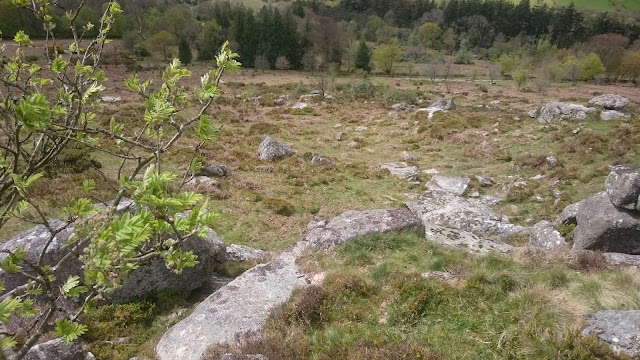
This month, I have been rekindling an old relationship with 'the book' - the Catalogue of Dartmoor Letterboxes. In fact I have only been looking for the registered letterboxes found within it's pages. Yes - I did a charity walk, which is also registered, but I was keen to avoid all the Word of Mouth boxes, that would usually form my routes.
Why? Well, I believe this is a great way to take the temperature of our hobby. Newbies will spend their money on this book, and use it to further their experience of Letterboxing. They need not have already found 100 boxes to purchase a copy - that rule no longer applies - so this book could be their ticket to join the 100 club, and spark future generation's interest in the pastime.
So where did the book take me this month?

I went on two trips. Two vastly different areas. One to deep Northern moor, remote, wild and rugged. Vergyland Combe, Brim Brook and Dinger Tor, to be precise, via East Mill. The other area more tame and familiar: Chinkwell and Honeybag Tors. So it was up North first, and a dozen-or-so boxes on my list, besides the MacMillan Cancer Support charity walk. The weather was great - warm, dry, calm and sunny. The car park at Row Tor wasn't overfull, and a dry few months meant that the going underfoot was reasonable. Everything was in my favour. I had almost total success with the charity walk, missing just one, but my success rate with my other clues wasn't so high. I located 5 catalogue boxes between West Mill and East Mill, but nothing further South of here. As enjoyable a-walk it was South of the Ring Road, it was a fruitless Letterbox walk.
Of the boxes that I failed to find up North, I cannot be truly certain that any are missing. I failed to find any ex-site, or any hint that I was searching where others had previously. The whole experience could be summarised by "Follow that dog", registered box number 36994. Sited in 2005, this box has distant bearings, none of which now seem to coincide. As I have previously said, 12 years will see a lot of natural bearing changes. There are no close up bearings, no indication of what the box is hidden under. It is my belief, that the only hope this box has, is to be found by chance.

My second catalogue-based-walk around the stunning ridge high above Widecombe was made up of 12 boxes - some long established, others comparatively new. I found 3 of them. I had 5 chance finds, which is to be expected anywhere near Bonehill Rocks. One of the 3 I did find, was registered box number 94. An original. Sited by Godfrey Swinscow, and now adopted by the Plymouth Get Together.
Perhaps though, this route's success could be summarised by box "Cook Family on Honeybag", registered number 49204, so less than a year old. This box has no bearings, and a vague clue. I paced 150 large paces from the wall up the hill, but was faced with countless rowan trees along the ridge. Suffice to say, I did not find this box. Perhaps the Cook family were inspired by Godfrey's 'original' clue, which is equally vague, but sadly far more obvious.
I respect the catalogue's values. I support the removal of 10 figure GPS from Letterbox clues - anything that helps to defeat the thief is good, plus I don't tend to use or rely on a GPS. Having a published code of conduct is vital, and 'other' boxes (travellers, boxes in other places) being provided a clear home is useful.
Perhaps the 5-year re-registration system of the 2000s was a wiser idea than we give it credit for. The concept of having to re-register a Letterbox after 5 years encourages ownership and responsible Letterboxing. I believe an original intention was to cap the number of 'live' boxes in the catalogue. A Letterbox requiring checking, clue updating, and regular attention is sure to receive more visits, and benefit the hobby as a whole. When the system ceased in 2012, the system again became 'self-governing', with deletions and new boxes balancing each other. It does however, leave us with a book of increasingly elderly boxes, which as my walk around Dinger Tor proved, has it's faults.
I want to conclude my challenge using the wise words of the foreword to the Letterbox Catalogue of Autumn 1986:
"The reputation for accuracy which the Catalogue has justly earned depends, in the first instance, on the accuracy of the information recorded"
This was part of a wider plea to support Godfrey Swinscow physically visit and personally check every clue and Letterbox before it's registration and publication in the catalogue. An arduous and exhausting job!
The catalogue was founded on professionalism, accuracy and reliability of the content. Anything that can be done to return to days when this is the norm, must be encouraged at all costs.












